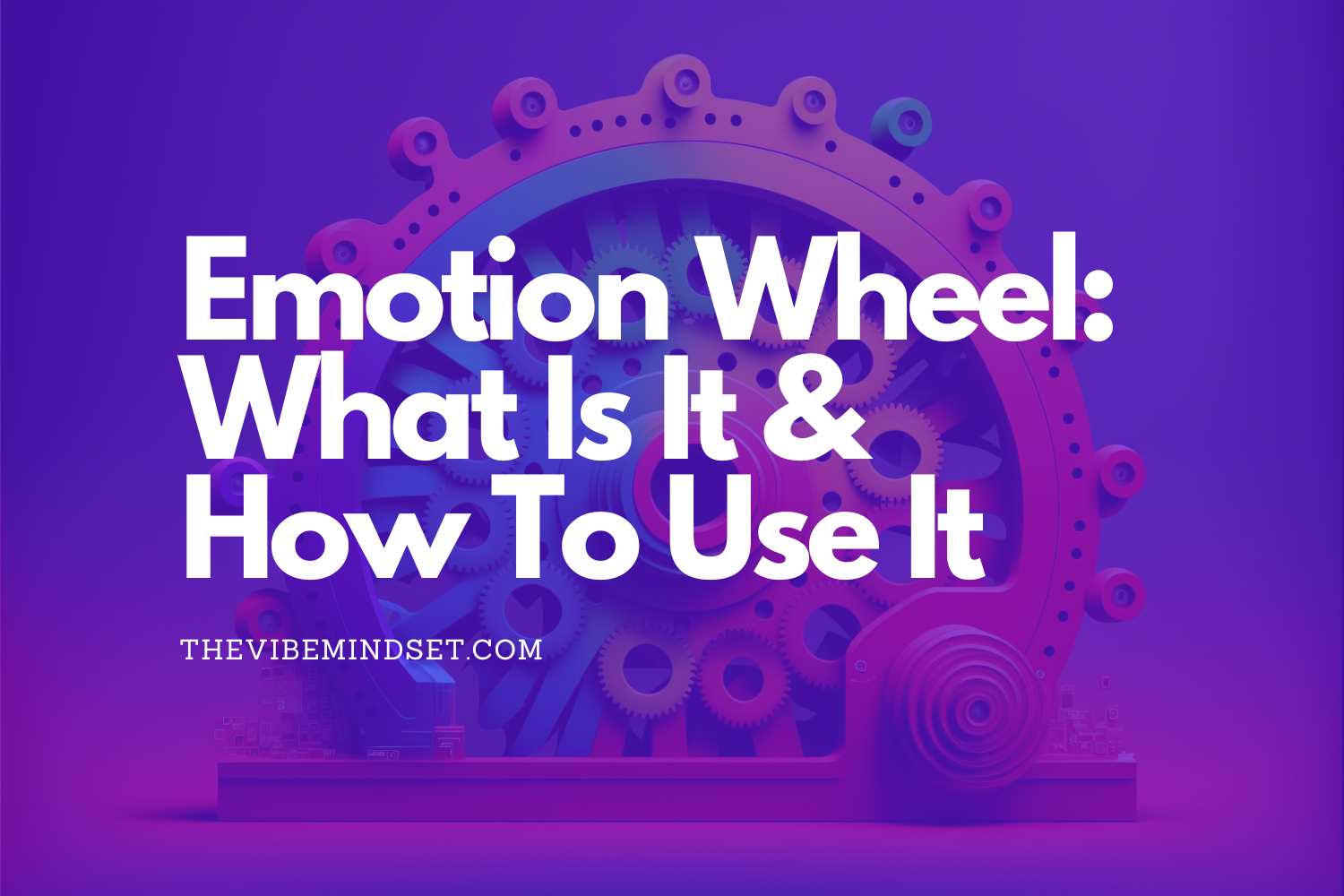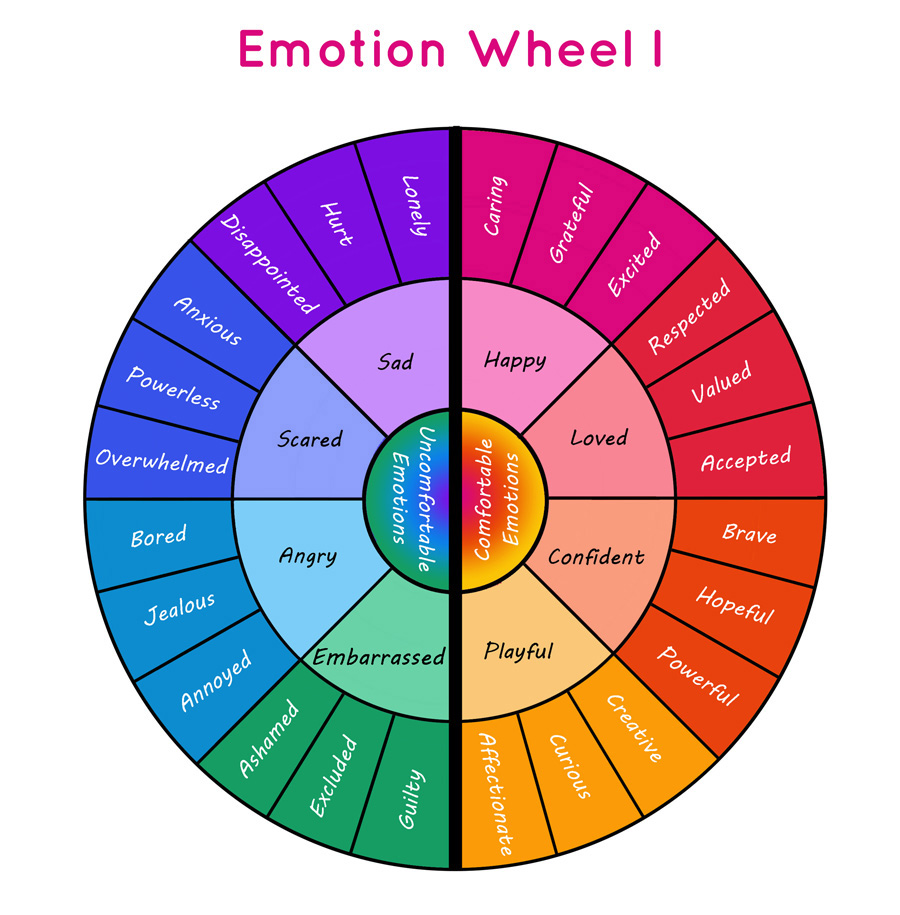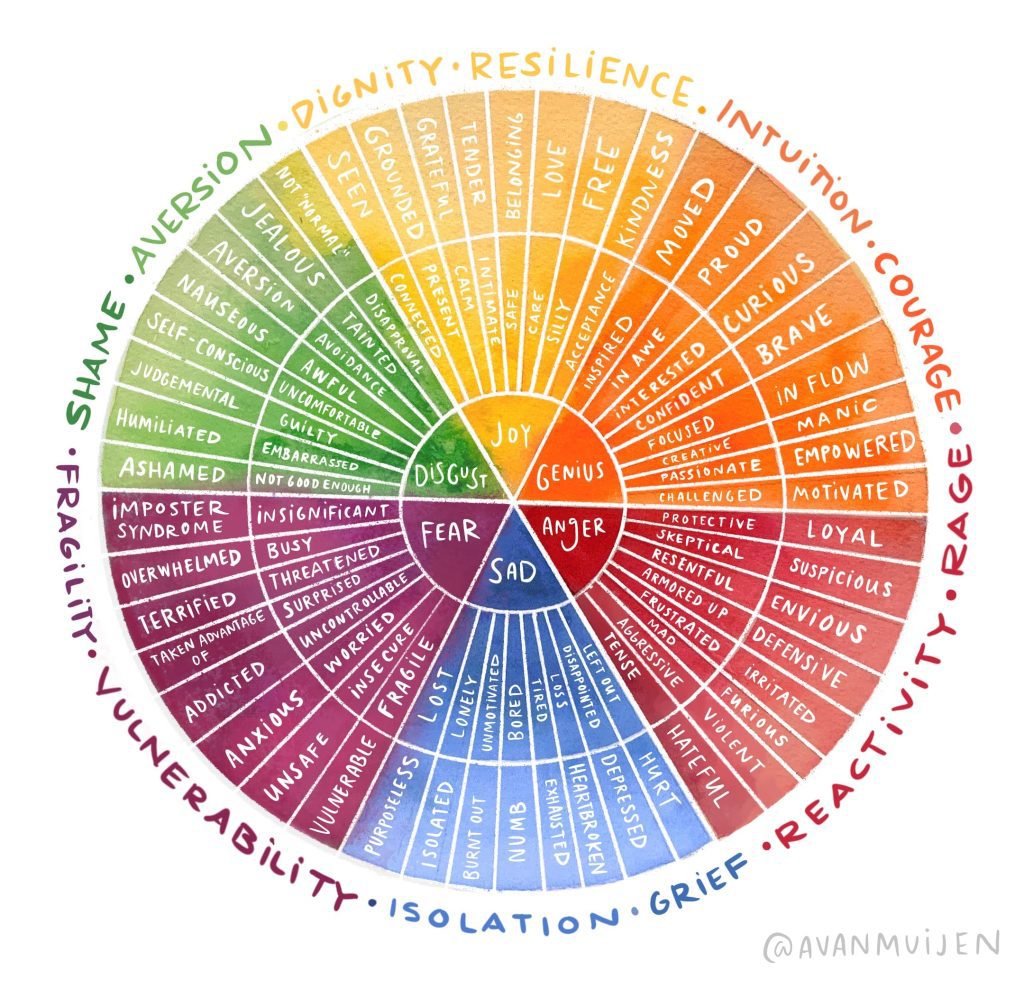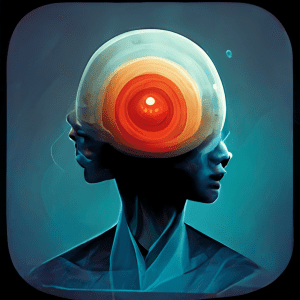An emotion wheel or feeling wheel is a useful tool for identifying emotions felt by physical sensations.
Emotion wheels are essential because self-awareness of one’s emotions is the first step in emotional intelligence.
Once we identify our emotions, we can identify their cause and how we would like to manage them.
This allows us to control our emotional response and emotional intensity better.
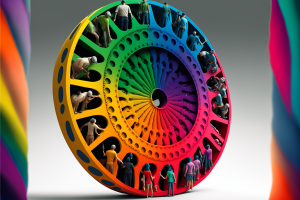
Table of Contents
What Is An Emotion Wheel
An emotions wheel is a visual representation of different emotions humans experience.
It typically consists of a circle divided into sections, each of which represents a different emotion.
The emotions are typically arranged to reflect their relationships, with closely related emotions placed near each other.
Some emotions wheels also include a label or description for each emotion to help people understand what it means and how it is experienced.
Emotion wheels can be helpful tools for understanding and expressing emotions, as they provide a structured way of organizing and categorizing feelings.
They can also be useful for identifying and naming emotions that people may not be familiar with or have difficulty describing.
Examples Of Emotion Wheels
How Does An Emotion Wheel Work?
An emotion wheel works by providing a colorful visual representation of different emotions and the relationships between them.
In the center are the eight core emotions.
You’ll find less intense variations of these core emotions when you reach the outer edges.
View these as primary and secondary emotions.
It is typically organized as a circle, with each section of the circle representing a different emotion.
The emotions are usually arranged in a way that reflects their relationship with one another, with closely related emotions placed near each other.
For example, emotions such as happiness, excitement, and contentment might be placed together, while emotions such as anger, frustration, and disappointment might be grouped together in a different section of the wheel.
To use an emotions wheel, you can start by looking at the emotions represented on the wheel and identifying which ones you are currently feeling.
You can then locate the section of the wheel that corresponds to that emotion and read the label or description to understand more about what that emotion means and how it is experienced.
You can also use the emotions wheel to identify and name emotions that you may not be familiar with or have difficulty describing.
In addition to helping you understand and express your emotions, an emotions wheel can also be a useful tool for helping others understand and express their emotions.
It can provide a common language and framework for discussing emotions, and it can help people to recognize and validate the emotions of others.
History Of The Emotion Wheel
The concept of an emotion wheel can be traced back to the work of psychologist Robert Plutchik, who developed a theory of emotions in the 1980s.
Robert Plutchik (1927 – 2006) was a psychologist at the Albert Einstein College of Medicine and acted as an adjunct professor in Florida.
He published an internationally respected author on emotions titled The Emotional – The Psycho Evolutionary Synthesis.
Plutchik proposed that there are eight primary emotions, which he referred to as “basic emotions”: anger, fear, sadness, disgust, surprise, anticipation, joy, and acceptance.
He argued that these basic emotions could be combined and blended in various ways to create more complex emotions.
Plutchik’s theory influenced the development of other emotion wheels, including the one developed by psychologist Paul Ekman in the 1990s.
Ekman’s emotion wheel includes only six basic emotions (anger, fear, sadness, disgust, joy, and surprise) and several secondary emotions formed by combining the basic emotions in different ways.
Since the development of these early emotion wheels, many other versions have been created, each with its own unique approach to organizing and representing emotions.
Some emotion wheels focus on a smaller number of basic emotions, while others include a wider range of emotions and may use different terminology to describe them.
Despite these differences, all emotion wheels aim to provide a useful tool for helping people understand and express their emotions.
Benefits Of The Emotion Wheel
The emotion wheel can be a helpful tool for understanding and expressing emotions and building emotional intelligence skills for several reasons:
- It provides a visual representation of a range of emotions: Seeing emotions represented visually can make it easier to understand and identify them.
- It helps to label emotions: Giving a name to an emotion can make it easier to understand and communicate.
- It can facilitate emotional regulation: By helping people to identify their emotions, the emotion wheel can facilitate emotional regulation – the ability to manage and control one’s emotions.
- It can improve communication: The emotion wheel can help people communicate more effectively about their emotions, both with themselves and others.
- It can be used as a tool for self-reflection: The emotion wheel can help people reflect on their emotions and understand their emotional states better.
- It can facilitate discussions about emotions: The emotion wheel can be a useful tool for facilitating discussions about emotions in group settings, such as therapy or counseling sessions.
Overall, the emotion wheel can be a helpful tool for improving emotional awareness and understanding and can be used in various settings to facilitate emotional growth and well-being.
How To Use An Emotion Wheel
Here are some steps for using an emotion wheel:
- Familiarize yourself with the emotions represented on the wheel. Different emotion wheels may include different emotions, so it’s essential to understand the specific emotions included on the wheel you are using.
- Identify an emotion you are feeling. Take a moment to reflect on your current emotional state. What emotions are you experiencing?
- Locate the emotion on the wheel. Once you have identified an emotion, try to locate it on the wheel. Some emotion wheels may include a brief description of each emotion to help you understand its meaning.
- Reflect on the intensity of the emotion. Some emotion wheels include a scale or gradient to help you understand the intensity of your emotion.
- Consider the causes of the emotion. What events or circumstances might have contributed to the emotion you are feeling? Understanding your emotions’ causes can help you manage and regulate them better.
- Consider how to express or manage the emotion. Once you have identified and understood an emotion, you may want to consider how to express or manage it. This might involve finding healthy ways to cope with difficult emotions or communicating about your emotions with others.
It’s essential to keep in mind that emotions are complex and can often be difficult to understand and express.
The feeling wheel is just one tool that can be helpful in improving emotional awareness and understanding, but it may not be suitable for everyone.
It’s also important to remember that it’s normal to experience a range of emotions and that it’s okay to feel a wide range of emotions in different situations.
What Are The Eight Primary Emotions
The eight primary emotions are anger, fear, sadness, disgust, surprise, anticipation, joy, and acceptance.
These primary emotions are a group of emotions proposed by psychologist Robert Plutchik in the 1980s.
According to Plutchik’s theory, the eight primary emotions are:
- Anger: a feeling of frustration or irritation, often accompanied by a desire to take action or to assert one’s power.
- Fear: anxiety or dread in response to a perceived threat or danger.
- Sadness: a feeling of sorrow or loss, often accompanied by feelings of hopelessness or despair.
- Disgust: a feeling of revulsion or distaste, often in response to something perceived as unpleasant or offensive.
- Surprise: a feeling of shock or astonishment in response to something unexpected.
- Anticipation: a feeling of excitement or nervousness in anticipation of something about to happen.
- Joy: a feeling of happiness or contentment, often in response to something pleasing or satisfying.
- Acceptance: a feeling of calm or resignation in response to something that cannot be changed.
Plutchik’s theory of the eight primary emotions suggests that they are fundamental and universal and can be combined and blended in various ways to create more complex emotions.
His theory has influenced the development of other emotion wheels and continues to contribute to the study of emotions.
An Emotional Wheel or Feeling Wheel Can Increase Emotional Intelligence
Using a feeling wheel can increase emotional intelligence in several ways:
- It can improve emotional awareness: The feeling wheel can help people to become more aware of their own emotions and to understand the range of emotions they experience. This can be especially helpful for people with difficulty identifying or expressing emotions.
- It can facilitate emotional regulation: By helping people to identify and understand their emotions, the feeling wheel can facilitate emotional regulation – the ability to manage and control one’s emotions. This can be especially helpful for people who struggle with managing difficult emotions or experience strong emotional reactions to certain situations.
- It can improve communication: The feeling wheel can help people communicate more effectively about their emotions, both with themselves and others. This can be especially helpful for people who may have difficulty expressing their emotions or have conflicts with others due to misunderstandings.
- It can be used as a tool for self-reflection: The feeling wheel can help people reflect on their emotions and understand their emotional states better. This can be especially helpful for people who may have difficulty understanding their own emotions or may feel overwhelmed by them.
Overall, using a feeling wheel can be a helpful tool for improving emotional intelligence by increasing emotional awareness, facilitating emotional regulation, improving communication, and self-reflection.
Next Steps
Access our best tool for managing emotions by clicking the image below!
- 5 Components Of Emotional Intelligence [WHAT ARE THEY?] - January 2, 2023
- 20 FREE Emotional Intelligence Images [For You] - January 2, 2023
- Low Frustration Tolerance: What Is It & [HOW TO IMPROVE] - December 31, 2022

